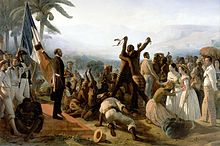Abolitionism
Abolitionism was a movement that wanted to end the practice of slavery in Europe and in America. It was mainly active during the 18th and 19th centuries. Until the 18th century, few people criticized slavery. But thinkers of the Enlightenment started to criticize it, because in their opinion slavery was against human rights. Communities like the Quakers thought that slavery was contradicting with Christianity.

In the early 19th century several countries abolished the transatlantic slave trade, and later in the century they abolished slavery itself.
Slavery in the Americas
changeRace-based slavery was established in the early 16th century in the Portuguese and Spanish Empires. It soon spread to the parts of British North America, New France, and Spanish America that would become the U.S. in the 18th century. By the beginning of the 18th century, enslavement of black Africans was powering the economy in these areas.[1] Most opposition to slavery was from enslaved people themselves.
During the American Revolution, beginning in 1775, the Virginia Governor, Lord Dunmore promised freedom to slaves and indenture servants "able and willing to take up arms" with the British. This proclamation would give freedom to the indentured servants and slaves held by the rebelling colonists, and wouldn't effect the loyalists. Many of the former slaves would die of disease, in fact 8 times as many blacks died of disease than died in battle. When the war ended, most slaves who decided to fight with the British were returned to servitude.[2] Some black Loyalists were taken to Canada and elsewhere.
The American Army of the revolution contained many blacks, most of them coming from New England. The most significant black regiment was the 1st Rhode Island. The Regiment was created in 1778 and consisted of mostly blacks. Upon joining the regiment, the commander, Colonel Christopher Greene, would release any slave from servitude.[3]
Following drafting, and signing of the new United States Constitution, blacks in the country were completely disenfranchised, and most remained slaves. Slavery began to decline. Most northern states outlawed its practice shortly after the Revolution, and in the south, Tobacco, the primary cash crop, was losing value[4] In 1794, Eli Whitney invented the cotton gin. This new invention helped to increase the profitability of cotton by mechanically removing its seeds. After 1800 the amount of cotton produced in the United States would double every 10 years. By the middle of the century, the United States produced three quarters of the worlds cotton.[5]
The Haitian Revolution, a slave rebellion that lasted from 1791 to 1804, changed the whole direction of the slave system.[6] In the next 100 years, slavery would be legally abolished in many of the colonies controlled by European empires.
References
change- ↑ "Indentured Servants in Colonial Virginia". www.encyclopediavirginia.org. Archived from the original on 2018-12-13. Retrieved 2018-09-18.
- ↑ "Fighting... Maybe for Freedom, but probably not". www.history.org. Archived from the original on 2018-09-18. Retrieved 2018-09-18.
- ↑ "1st Rhode Island Regiment | The Black Past: Remembered and Reclaimed". www.blackpast.org. 17 November 2010. Archived from the original on 2018-09-30. Retrieved 2018-09-18.
- ↑ ushistory.org. "Revolutionary Changes and Limitations: Slavery [ushistory.org]". www.ushistory.org. Archived from the original on 2018-08-30. Retrieved 2018-09-18.
- ↑ "Eli Whitney's Patent for the Cotton Gin". National Archives. 2016-08-15. Archived from the original on 2018-09-21. Retrieved 2018-09-18.
- ↑ Gaffield, Julia. "Haiti was the first nation to permanently ban slavery". Washington Post. ISSN 0190-8286. Archived from the original on 2021-01-01. Retrieved 2020-11-17.